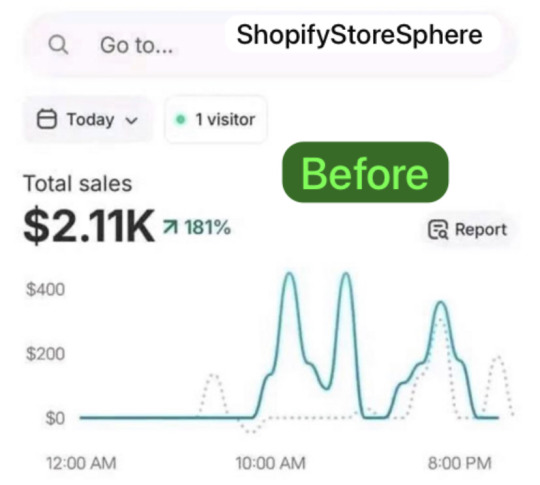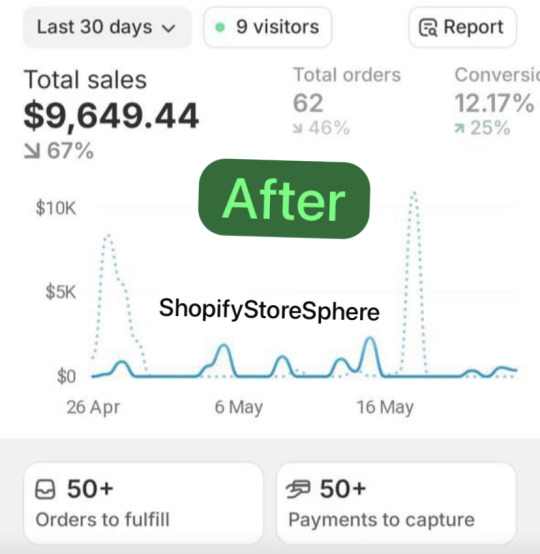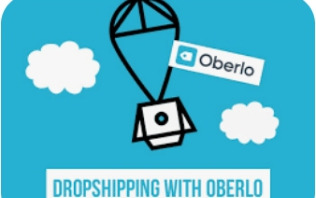#custom shopify dropshiping
Explore tagged Tumblr posts
Text
Explore the advantages and disadvantages of using Shopify for dropshipping in 2024. Learn about Shopify's user-friendly interface, customization options, and scalability, along with considerations such as cost, transaction fees, and competition. Consider hiring Webgarh Solutions for expert Shopify dropshipping store development services to maximize your e-commerce success.
#shopify#dropshipping#ecommerce#shopify store#customization#shopify apps#payment gateways#ecommerce platforms#web development#shopify development#webgarh solutions
2 notes
·
View notes
Text
Shopify Store Creation: A Step-by-Step Guide
#Shopify store setup#E-commerce website development#Online store creation#Shopify website design#Shopify store customization#E-commerce platform selection#Shopify store management#Online business setup#Dropshipping with Shopify#Shopify SEO optimization#Shopify payment integration#Shopify theme development#Shopify app installation#Social media marketing for Shopify#Shopify store promotion
8 notes
·
View notes
Text



#shopifythemedevelopment#shopify tips#shopify theme customization#shopifyseo#shopifyseller#shopify designers#shopify sales#shopify services#shopify#shopifystore#online shoping#shopifysuccess#shopify speed optimization service#small business#dropshipping#smallbiz#etsyseller#ebaystore#amazon#walmart inc#redbubble
0 notes
Text
How to start a profitable dropshipping store on Shopify
Ignite Your Entrepreneurial Dreams: Unlock the Secrets to Building a Thriving Shopify Dropshipping Empire Dropshipping is a revolutionary e-commerce model that has transformed the way entrepreneurs approach online business. By leveraging the power of Shopify, you can create a thriving dropshipping empire and turn your entrepreneurial dreams into reality. In this comprehensive guide, we���ll unveil…
0 notes
Text
As you consider enhancing your online presence, I’d love the opportunity to discuss how a website design or redesign could help you achieve your goals. Whether starting from scratch or reimagining your digital footprint, I’m confident we can create a powerful and effective solution. Can you send me a message to explore this further?
Looking forward to connecting! https://zeep.ly/EYyrp #Shopify #Shopifydesign#Shopifystore #websitedesign #ecommerce #redbubble #zazzle #socialmediamanagement #socialmediamanager #sopifyredesign #storeredesign

#dropshipping#virtual assistant#marketing#ecommercesolutions#online store#crafts#onlinebusiness#businesssolutions#amazon#small business#shopify#online shoping#etsy#etsyartist#etsy owner#artists on etsy#etsysale#etsy custom air freshener#etsyshop#etsyfinds#etsygifts#etsyhandmade#etsyseller#etsyuk#etsysmallbusiness#etsyjewelry#etsystore#etsyvintage#etsylove#ecommerce
1 note
·
View note
Text

Turning Shopify Returns into Opportunities: 6 Powerful Strategies for Upselling and Retention
In the world of e-commerce, returns are often viewed as a necessary evil – a cost of doing business that eats into profits and disrupts operations. However, returns can also present valuable opportunities for upselling and customer retention. By implementing the right strategies, Shopify returns can be transformed from a burden into a powerful tool for growth. Let’s dive right in...
1 note
·
View note
Text
#Custom eCommerce Web Design Services#eCommerce Web Design Services#Custom eCommerce Website Design Services#eCommerce Website Design Services#eCommerce Store Design Services#Custom eCommerce Store Design Services#Affiliate eCommerce Website Design Service#Affiliate eCommerce Website Development Service#Dropshipping eCommerce website Design Service#Dropshipping eCommerce website Development#eCommerce Web Development Services#Custom eCommerce Web Development Services#Custom eCommerce Website Development Services#eCommerce Website Development Services#eCommerce Development Services#Custom eCommerce Development Services#eCommerce Store Development Services#WooCommerce Store Development Services#WooCommerce eCommerce Development Services#Shopify Store Development Services#Shopify eCommerce Development Services#eCommerce Development Company#Best eCommerce Development Company
0 notes
Text
#Custom eCommerce Web Design Services#eCommerce Web Design Services#Custom eCommerce Website Design Services#eCommerce Website Design Services#eCommerce Store Design Services#Custom eCommerce Store Design Services#Affiliate eCommerce Website Design Service#Affiliate eCommerce Website Development Service#Dropshipping eCommerce website Design Service#Dropshipping eCommerce website Development#eCommerce Web Development Services#Custom eCommerce Web Development Services#Custom eCommerce Website Development Services#eCommerce Website Development Services#eCommerce Development Services#Custom eCommerce Development Services#eCommerce Store Development Services#WooCommerce Store Development Services#WooCommerce eCommerce Development Services#Shopify Store Development Services#Shopify eCommerce Development Services#eCommerce Development Company#Best eCommerce Development Company
0 notes
Text
Oberlo Dropshipping: Streamlining Your E-commerce Success"
Oberlo has revolutionized the dropshipping industry by offering a seamless platform that integrates with e-commerce platforms like Shopify, making it easier than ever for entrepreneurs to start and scale their online businesses. With Oberlo, entrepreneurs can quickly import products from suppliers, customize their storefronts, and automate order fulfillment, allowing them to focus on growing…

View On WordPress
#Analytics#Customer Service#Digital Marketing#Dropshipping#E-commerce#Entrepreneurship#Marketing Strategy#Niche Targeting#Oberlo#Online Business#Optimization#Product Selection#Product Sourcing#Shopify#Supplier Relations
0 notes
Text
Fast-Track to Online Income: Comprehensive Strategies to Earn Money and Grow Quickly in E-commerce

Introduction
The digital landscape has significantly transformed the way we conduct business, opening up countless opportunities for generating income online. E-commerce, a sector that has seen exponential growth over the years, has become a key player in the digital economy, offering anyone with an internet connection a chance to jump into the world of online selling.
While it’s important to maintain realistic expectations — you won’t become a millionaire overnight — with the right approach, strategic planning, and a good deal of determination, it’s certainly possible to start earning money online in a matter of weeks, perhaps even days. This article will offer an in-depth, step-by-step guide to help you hit the ground running and fast-track your online income through e-commerce.
Part 1: Dropshipping — A Quick Start
Why Dropshipping?
The beauty of dropshipping lies in its simplicity and low entry barrier. It’s an e-commerce model where you don’t handle the products you sell. Instead, you work with a supplier who stores, packs, and ships the products on your behalf. This means you can start selling without a huge capital investment or the hassle of inventory management.
Finding a Reliable Supplier
Your supplier is your business partner, and their performance directly affects your customer satisfaction. You can find suppliers on platforms like AliExpress, Oberlo, SaleHoo, or Doba. Check for suppliers with excellent reviews, reliable shipping, and high-quality products. Remember, the cheapest supplier may not always be the best choice.
Choosing Profitable Products
Your product choice can make or break your business. Focus on niche products that are trending but not overly saturated. Tools like Google Trends, Niche Scraper, and Trend Hunter can help you identify potential winning products.
Pricing Your Products
Pricing is a crucial part of your business strategy. It should be high enough to cover your costs and generate a profit, but low enough to attract customers. Consider your target audience, product quality, and market competition when setting prices.
Part 2: Building Your Online Store
Why Shopify?
Shopify is a leading e-commerce platform known for its user-friendly interface, robust functionality, and excellent customer support. It offers a 14-day free trial that allows you to set up your store and get comfortable with the platform before committing to a paid plan.
Designing Your Shopify Store
Your online store is your virtual storefront, and its design should create a positive first impression. Choose a clean, professional Shopify theme that aligns with your brand identity. The layout should be intuitive, with a focus on user experience. Ensure your website is mobile-friendly, as a significant portion of online shopping happens on mobile devices.
Creating Stellar Product Listings
Your product page is where the selling happens. Each product listing should include an engaging title, a detailed description, high-quality images, and a clear call-to-action. Highlight the benefits of your products and why customers should choose them over competitors.
Setting Up Payments and Shipping
Shopify supports a wide range of payment gateways, including PayPal, Stripe, and credit card payments, making it easy for customers worldwide to shop from your store. For shipping, you can use the rates provided by your dropshipping supplier. Be clear and transparent about shipping costs and times on your product pages and checkout process.
Part 3: Pre-Launch Marketing
Why Pre-Launch Marketing?
Building hype before your store’s launch can help you hit the ground running. Use this period to create a community around your brand, generate interest in your products, and build anticipation for your launch.
Building an Email List
An email list is a powerful marketing tool. Use lead magnets — incentives you offer to potential buyers in exchange for their email address — to encourage website visitors to subscribe to your mailing list. This could be a discount on their first purchase, a free ebook, or exclusive access to pre-launch products.
Social Media Teasers
Leverage social media platforms like Instagram, Facebook, and Pinterest to share teaser posts about your upcoming store launch. These could be behind-the-scenes looks at your product selection process, sneak peeks of your products, or countdown posts leading up to the launch. Remember, engagement is key. Respond to comments and messages, and build genuine relationships with your followers.
Part 4: Launching Your Store
The Grand Opening
Now that you’ve built up anticipation, it’s time for the big reveal. Announce the launch on your social media channels and send out an email blast to your subscribers. To encourage initial purchases, consider offering a special launch-day discount or a small gift with every purchase.
Leveraging Social Media for Promotion
Stay active on your social media channels. Regularly post engaging content, interact with your followers, and promote your products creatively. Consider running contests or giveaways to increase engagement and reach. Also, don’t shy away from paid advertising on social media — it can be an effective way to reach a larger audience.
Part 5: Post-Launch Marketing Strategies
Influencer Marketing
Influencer marketing is a powerful tool in the e-commerce world. Influencers have established audiences who trust their recommendations. Partnering with influencers in your niche can drive significant traffic to your store and boost your sales.
Running Paid Ads
Paid advertising, particularly on platforms like Facebook and Instagram, can be a game-changer for your online store. With the ability to target specific demographics based on interests, location, age, and more, you can reach potential customers who are likely to be interested in your products. Start with a small budget and gradually increase it as you see positive results.
Search Engine Optimization (SEO)
SEO is a long-term strategy that can drive organic traffic to your store. It involves optimizing your website and product pages to rank higher in search engine results. This can be done by using relevant keywords in your content, optimizing your website’s loading speed, and building high-quality backlinks.
Part 6: Fostering Growth and Expansion
Prioritizing Customer Service
Excellent customer service can set you apart from your competitors. Ensure you respond to customer inquiries quickly and professionally. If issues arise with orders, handle them promptly and to the customer’s satisfaction. Happy customers are more likely to become repeat customers and refer others to your store.
Analyzing and Optimizing
Regularly review your store’s performance using analytics tools like Google Analytics or Shopify’s built-in analytics. These tools provide valuable insights into your customers’ behavior, popular products, and traffic sources. Use this information to optimize your website, marketing strategies, and product selection.
Expanding Your Product Range
As your business grows and you gain a better understanding of your customers, consider expanding your product range. This could mean adding new products within your existing niche or branching out into complementary niches. However, ensure any new products align with your brand and are likely to appeal to your target audience.
Part 7: Scaling Your Business
Moving Beyond Dropshipping
Once you’ve built a stable income stream through dropshipping, consider exploring other e-commerce business models. For instance, you could transition into wholesaling or even manufacturing your own products. This could increase your profit margins, give you more control over product quality, and allow you to offer unique products that set you apart from the competition.
Building a Strong Brand
As your business grows, focus on building a strong brand. A compelling brand story, a consistent visual identity, and a clear value proposition can help you establish a strong market presence. Invest in quality branding elements such as a professional logo, a unique color palette, and a consistent tone of voice in all your communication. Remember, a strong brand can command customer loyalty and distinguish you from competitors.
Investing in Advanced Marketing Strategies
As your business scales, so should your marketing efforts. Consider more advanced strategies such as content marketing, email automation, retargeting ads, and even hiring an SEO consultant.
Content Marketing: Regularly publishing high-quality, relevant content can drive traffic to your site, improve your SEO, and position your brand as an authority in your niche. This could be blog posts, how-to guides, or even video content.
Email Automation: Automated email campaigns can help you nurture relationships with your customers. This could include welcome emails, cart abandonment reminders, and personalized product recommendations.
Retargeting Ads: Retargeting ads can help you reach people who have previously interacted with your brand, reminding them of their interest and encouraging them to complete a purchase.
SEO Consulting: As your store grows, you may want to consider hiring an SEO consultant. They can provide expert advice and implement advanced strategies to help your store rank higher in search engine results.
Part 8: Mastering Customer Retention
Why Customer Retention Matters
Acquiring new customers is important, but retaining existing ones is just as crucial. In fact, it’s often more cost-effective to retain a customer than to acquire a new one. A loyal customer base can provide a steady stream of revenue and serve as brand ambassadors, promoting your business through word-of-mouth marketing.
Implementing a Loyalty Program
A loyalty program can incentivize repeat purchases by rewarding customers for their loyalty. This could be a points-based system where customers earn points for every dollar spent, which can be redeemed for discounts or free products. Or, it could be a VIP program offering exclusive perks to members.
Offering Excellent Post-Purchase Support
Post-purchase support is a crucial part of customer retention. This includes answering any questions or concerns customers may have about their purchase, providing easy and hassle-free returns or exchanges, and following up with customers to ensure they’re satisfied with their purchase.
Part 9: Exploring International Markets
The Benefits of Going Global
Expanding your e-commerce business to international markets can open up a whole new customer base, significantly increasing your sales potential. Additionally, it can help spread risk — if sales dip in one market, they may be up in another.
Conducting Market Research
Before expanding internationally, conduct thorough market research to understand the demand for your products in different markets, the competition, and any cultural nuances that could affect your marketing and sales strategies.
Overcoming Logistics Challenges
International expansion comes with logistical challenges, such as shipping, taxes, and customs. Partnering with international shipping providers and understanding the tax and customs regulations of the countries you’re selling in can help you overcome these challenges.
Part 10: Preparing for the Future
Staying Ahead of E-commerce Trends
The e-commerce landscape is constantly evolving, and staying ahead of trends can give you a competitive edge. This could involve adopting new technologies (like AR and VR for product visualization), exploring new marketing strategies (like TikTok marketing), or even expanding into new product categories.
Investing in Sustainability
Sustainability is becoming increasingly important to consumers. Incorporating sustainability into your business — whether through eco-friendly packaging, sustainable sourcing, or carbon offset shipping — can not only help the environment, but also attract a new segment of eco-conscious consumers.
Adapting to Changes in Consumer Behavior
Consumer behavior is continually changing, influenced by social, economic, and technological factors. Regularly reviewing your sales data, keeping an eye on industry trends, and actively seeking customer feedback can help you stay in tune with changes in consumer behavior and adapt your business accordingly.
Part 11: Building a Team
As your e-commerce business grows, you may need to expand your team to handle the increasing workload and bring in new skills and perspectives.
Hiring the Right People
Hiring the right people is crucial for the success of your business. Look for individuals who are passionate about your industry, align with your company culture, and have the skills and experience needed for their role.
Delegating Tasks
As a business owner, it’s important to delegate tasks so you can focus on strategic decision-making. Assign operational tasks (like order fulfillment and customer service) to your team members, and consider outsourcing specialized tasks (like SEO and content creation) to experts.
Building a Positive Company Culture
A positive company culture can improve employee satisfaction and productivity. Foster a culture of open communication, recognize and reward hard work, and provide opportunities for professional growth.
Part 12: Keeping the Momentum Going
Building a successful e-commerce business is a marathon, not a sprint. Even after achieving initial success, it’s important to keep pushing forward and striving for growth.
Continually Optimizing Your Store
E-commerce is a fast-paced industry, and what worked yesterday may not work tomorrow. Regularly review and optimize your store based on performance data and industry trends. This could involve tweaking your website design, improving product descriptions, or optimizing your checkout process.
Expanding Your Marketing Efforts
As your business grows, you should continually expand and diversify your marketing efforts. Test new marketing channels, experiment with different ad formats, and continually optimize your campaigns based on performance data.
Innovating and Experimenting
Don’t be afraid to innovate and experiment. Whether it’s launching a new product line, trying a new marketing strategy, or experimenting with a new business model, taking calculated risks can lead to big rewards.
Conclusion
While the promise of fast money in e-commerce is enticing, it’s important to remember that building a successful online business requires strategic planning, hard work, and a commitment to continuous learning and adaptation. It’s not about getting rich quick, but about building a sustainable business that can provide a steady income stream over time.
The roadmap outlined in this article offers a comprehensive guide to fast-tracking your online income. By starting with dropshipping, setting up an attractive and user-friendly online store, leveraging pre-launch and post-launch marketing strategies, and focusing on customer satisfaction, analysis, and optimization, you can set your e-commerce business up for success. As your business grows, you can explore other business models and advanced marketing strategies to further increase your income.
So, are you ready to embark on your e-commerce journey? With this detailed guide, you’re well-equipped to fast-track your path to earning online income. Remember, every successful business started somewhere, and today could be your day one. So, take that first step, and let the journey begin!
#E-commerce#Online Income#Quick Money#Dropshipping#Shopify#Marketing Strategies#Influencer Marketing#SEO#Customer Service#Business Analytics#Product Expansion#Business Scaling#Brand Building#E-commerce Success#Online Business#Profitability#Business Launch
1 note
·
View note
Text
Discover 7 proven strategies to drive traffic to your Shopify dropshipping store. From SEO and content marketing to influencer partnerships and email campaigns, learn how to boost sales effectively. Partner with Webgarh Solutions for expert Shopify development services tailored to your business goals.
#shopify dropshipping store development#shopify dropshipping store#hire shopify dropshipping developer#custom dropshipping store#shopify tips#dropshipping success#ecommerce strategies#shopify development#webgarh solutions
0 notes
Text
30 ways to make real; money from home
Making money online from the comfort of your home has become increasingly accessible with the growth of the internet and digital technologies. In 2023, there are numerous realistic ways to earn money online. Here are 30 ideas to get you started:
1. Freelance Writing: Offer your writing skills on platforms like Upwork or Freelancer to create blog posts, articles, or website content.
2. Content Creation: Start a YouTube channel, podcast, or blog to share your expertise or passion and monetize through ads, sponsorships, and affiliate marketing.
3. Online Surveys and Market Research: Participate in online surveys and market research studies with platforms like Swagbucks or Survey Junkie.
4. Remote Customer Service: Work as a remote customer service representative for companies like Amazon or Apple.
5. Online Tutoring: Teach subjects you're knowledgeable in on platforms like VIPKid or Chegg Tutors.
6. E-commerce: Start an online store using platforms like Shopify, Etsy, or eBay to sell products.
7. Affiliate Marketing: Promote products or services on your blog or social media and earn commissions for sales made through your referral links.
8. Online Courses: Create and sell online courses on platforms like Udemy or Teachable.
9. Remote Data Entry: Find remote data entry jobs on websites like Clickworker or Remote.co.
10. Virtual Assistance: Offer administrative support services to businesses as a virtual assistant.
11. Graphic Design: Use your graphic design skills to create logos, graphics, or websites for clients on platforms like Fiverr.
12. Stock Photography: Sell your photos on stock photography websites like Shutterstock or Adobe Stock.
13. App Development: Develop and sell mobile apps or offer app development services.
14. Social Media Management: Manage social media accounts for businesses looking to enhance their online presence.
15. Dropshipping: Start an e-commerce business without holding inventory by dropshipping products.
16. Online Consultations: Offer consulting services in your area of expertise through video calls.
17. Online Surplus Sales: Sell unused items or collectibles on platforms like eBay or Facebook Marketplace.
18. Online Fitness Coaching: Become an online fitness coach and offer workout plans and guidance.
19. Virtual Events: Host webinars, workshops, or conferences on topics you're knowledgeable about.
20. Podcast Production: Offer podcast editing, production, or consulting services.
21. Remote Transcription: Transcribe audio and video files for clients.
22. Online Translation: Offer translation services if you're proficient in multiple languages.
23. Affiliate Blogging: Create a niche blog with affiliate marketing as the primary revenue source.
24. Online Art Sales: Sell your artwork, crafts, or digital art on platforms like Etsy or Redbubble.
25. Remote Bookkeeping: Offer bookkeeping services for small businesses from home.
26. Digital Marketing: Provide digital marketing services like SEO, PPC, or social media management.
27. Online Gaming: Stream your gaming sessions on platforms like Twitch and monetize through ads and donations.
28. Virtual Assistant Coaching: If you have experience as a VA, offer coaching services to aspiring virtual assistants.
29. Online Research: Conduct research for businesses or individuals in need of specific information.
30. Online Real Estate: Invest in virtual real estate, such as domain names or digital properties, and sell them for a profit.
Remember that success in making money online often requires dedication, patience, and the ability to adapt to changing trends. It's essential to research and choose the opportunities that align with your skills, interests, and long-term goals.
#founder#accounting#ecommerce#copywriting#business#commercial#economy#branding#entrepreneur#finance#make money online#earn money online#make money from home#old money#i turn to these cute#disgraced youtuber ruby franke#my mum#money#claims shock report#says terrified brit#easy money
74 notes
·
View notes
Text
How to make money online?
Making money online involves various methods, depending on your skills, interests, and resources. Here are some popular ways to make money online:
Freelancing: Offer your skills and services on freelance platforms like Upwork, Freelancer, or Fiverr. Common freelance jobs include writing, graphic design, programming, digital marketing, and virtual assistance.
Online Tutoring or Coaching: If you have expertise in a particular subject or skill, you can offer tutoring or coaching services through platforms like Tutor.com, Chegg Tutors, or Skillshare.
E-commerce: Start an online store to sell products. You can create your own e-commerce website using platforms like Shopify or sell on established marketplaces like Amazon, eBay, or Etsy.
Affiliate Marketing: Promote products or services and earn a commission for each sale made through your referral link. Join affiliate programs of companies in your niche or use affiliate networks like Amazon Associates, ClickBank, or ShareASale.
Content Creation: Monetize your content by creating a blog, YouTube channel, podcast, or social media presence. You can earn money through advertising, sponsorships, affiliate marketing, or selling digital products.
Online Surveys and Market Research: Participate in online surveys, focus groups, or market research studies to earn rewards or cash. Websites like Swagbucks, Survey Junkie, and UserTesting offer opportunities for paid surveys and testing products.
Dropshipping: Start a dropshipping business where you sell products to customers without holding inventory. When a customer makes a purchase, you purchase the product from a third party who then ships it directly to the customer.
Stock Photography: If you have photography skills, you can sell your photos online to stock photography websites like Shutterstock, Adobe Stock, or Getty Images.
Virtual Events and Webinars: Host virtual events, workshops, or webinars on topics you're knowledgeable about and charge attendees for access.
Online Courses and Digital Products: Create and sell online courses, eBooks, templates, or digital downloads on platforms like Udemy, Teachable, or Gumroad.
Remember that success in making money online often requires patience, persistence, and continuous learning. It's essential to choose methods that align with your skills and interests and to be wary of scams or get-rich-quick schemes promising unrealistic returns.
#etsy#how to sell on etsy#make money online#how to make money online#passiveincome#money#online#mony online#make money
19 notes
·
View notes
Text
Maximize Efficiency and Profit with Dropship Automation
In today’s fast-paced e-commerce world, managing an Automation business efficiently can be challenging. Between managing orders, customer service, inventory, and supplier relationships, it can feel overwhelming. That’s where Dropship Automation comes in transforming your business by streamlining processes, saving time, and improving profitability.
What is Dropship Automation?
Dropship automation refers to the use of software tools and systems that help automate various aspects of your Automation business. This includes inventory management, pricing updates, and even customer support. By automating these time-consuming tasks, you free up valuable time to focus on growing your business and creating a better customer experience.
Key Benefits of Dropship Automation
Time-Saving Efficiency
Running an Automation store involves multiple steps: processing orders, checking stock levels, updating product information, and more. Dropship automation tools handle these repetitive tasks for you, reducing the risk of human error and saving you hours every week. This allows you to focus on marketing, customer acquisition, and scaling your business.
Improved Accuracy and Reduced Errors
Manual processes are prone to mistakes—whether it’s entering wrong pricing, inventory mismatches, or missing a crucial order. Automation ensures that data is synchronized across all platforms, keeping your inventory levels up to date, and preventing overselling or stock outs.
Enhanced Customer Experience
Customers expect fast and reliable service. With dropship automation, orders are processed more quickly, and stock levels are updated in real-time. This results in fewer delays and stock discrepancies, leading to better customer satisfaction and repeat business.
Scaling Your Business
One of the biggest advantages of dropship automation is that it enables you to scale effortlessly. As your business grows, so do the complexities of managing orders and products. Automation tools can handle a larger volume of transactions without additional manual work, giving you the freedom to expand without worrying about operational bottlenecks.
Why Choose Dropship Automation?
Dropship Automation offers an all-in-one solution to simplify your operations and boost your business efficiency. With integrations to popular platforms like Shopify and Big Commerce, and support for numerous suppliers, it’s the perfect tool for anyone serious about running a successful Automation business.
2 notes
·
View notes
Text
1. Freelancing
Skills needed: Web development, SEO, writing, graphic design, video editing, digital marketing, etc.
Platforms: Upwork, Fiverr, Freelancer, and Toptal.
Tip: Building a niche and focusing on high-demand services can help maximize earnings.
2. Content Creation
YouTube: Monetize videos through ads, sponsored content, and memberships.
Blogging: Earn through affiliate marketing, ads (Google AdSense), and sponsored posts.

TikTok/Instagram: Partner with brands or sell products through affiliate marketing.
3. E-commerce
Dropshipping: Sell products without holding inventory via platforms like Shopify.
Print-on-Demand: Use services like Printful to create and sell custom products.
2 notes
·
View notes
Text
How to Make Money Online: A Comprehensive Guide
In today’s digital age, making money online has become more accessible than ever. Whether you’re looking to supplement your income or start a full-fledged online business, there are numerous opportunities available. Here are some of the best ways to make money online:
1. Freelancing
Freelancing is a great way to leverage your skills and earn money. Platforms like Upwork, Fiverr, and Freelancer connect freelancers with clients looking for services such as writing, graphic design, programming, and more. To get started:
Create a compelling profile showcasing your skills and experience.
Start with smaller projects to build your portfolio and gain positive reviews.
Set competitive rates and gradually increase them as you gain more experience.
2. Affiliate Marketing
Affiliate marketing involves promoting products or services and earning a commission for every sale made through your referral link. To succeed in affiliate marketing:
Choose a niche that interests you and has a good market potential.
Join reputable affiliate programs like Amazon Associates, ClickBank, or CJ Affiliate.
Create high-quality content that attracts and engages your audience.
Use SEO techniques to drive organic traffic to your content.
3. Online Courses and Ebooks
If you have expertise in a particular field, consider creating and selling online courses or ebooks. Platforms like Udemy, Teachable, and Amazon Kindle Direct Publishing make it easy to reach a global audience. Steps to get started:
Identify a topic that you are knowledgeable about and that has demand.
Create comprehensive and engaging content.
Promote your course or ebook through social media, email marketing, and your website.
4. Blogging
Blogging can be a lucrative way to make money online if done correctly. To monetize your blog:
Choose a niche that you are passionate about and that has a potential audience.
Consistently create valuable and engaging content.
Use affiliate marketing, sponsored posts, and display ads to generate income.
Build an email list to keep your audience engaged and informed about new content.
5. Dropshipping
Dropshipping allows you to sell products without holding any inventory. When a customer makes a purchase, the product is shipped directly from the supplier to the customer. To start a dropshipping business:
Choose a niche with high demand and low competition.
Find reliable suppliers through platforms like AliExpress or Oberlo.
Set up an online store using Shopify or WooCommerce.
Promote your store through social media, SEO, and paid advertising.
6. Online Surveys and Market Research
Participating in online surveys and market research can be an easy way to earn extra cash. Websites like Swagbucks, Survey Junkie, and Vindale Research pay users for their opinions on various products and services. While this won’t make you rich, it’s a simple way to earn some extra money in your spare time.
Conclusion
Making money online requires dedication, patience, and a willingness to learn. By leveraging your skills and exploring different opportunities, you can find the right path for you. Start small, stay consistent, and watch your online income grow over time.
2 notes
·
View notes